
[Algolia Result Count is not loaded]
[Algolia SearchHits is not loaded]

Guidance for Testing CD285U RCCB
Devices produced up to july 2019.
** Please note: This guidance DOES NOT apply to CD285U RCCB with a production date code after 19219 **
The new range of Hager Type A RCCBs conform to BS EN 61008-1 Amended 2017. This standard recognises RCCBs not exceeding 30 mA as providing additional protection against electric shock.
Table 1 of BS EN 61008-1 specifies the manufacturer’s option of a maximum break time (commonly referred to as tripping) for a 30 mA RCCB as 40 ms at a test current of 250 mA. This is aligned to IEC TS 60479 which relates to the effects of electric current on humans and which recognises 250 mA disconnecting within 40 ms. This was reflected in the 18th edition BS 7671 in the note under 643.8 which states:
Effectiveness is deemed to have been verified where an RCD meeting the requirements of Regulation 415.1.1 disconnects within 40 ms when tested at a current equal to or higher than five times its rated residual operating current.
Unfortunately, the acceptable test parameter of a maximum trip time of 40 ms at 250 mA has not yet been transferred to industry guidance which still describes a single test option i.e. disconnect within 40 ms at 5IΔn and is therefore still the recognised practice in the UK.
Test Readings
The product standard BS EN 61008-1 allows the manufacturer to select characteristics of 5xI∆n or 0.25 A / 250 mA. The Hager RCCB is set to 0.25 A / 250 mA which allows conformity to both the product standard and BS 7671.
Test Procedure
Market feedback indicates that there may be a general issue around how to correctly test 30 mA RCCBs set to 0.25 A.
Regulation 643.8 requires the verification to be made by visual inspection and testing. The test could be carried out using either the ‘Auto’ function of the installation test meter or manually selecting each test in turn. We recommend the RCCB test is carried out in ‘manual mode’. The test should be carried out at the device itself with all loads disconnected, as described in IET Guidance Note 3 and IET On-Site-Guide.
The test equipment should be selected to the type of RCCB corresponding to the type of RCCB within the installation.
Should you wish to carry out a test at 250mA, where the required disconnection time is within 40 ms, a variable RCCB test instrument can be set to 50 mA and tested at X5, which is in effect carrying out the test at 250 mA, as permitted by the note under Regulation 643.8.
Also should your particular test instrument not have a variable facility then it is acceptable to carry out the test at a higher value of 300mA (set machine to 300mA and x1) to achieve a time within 40ms.
The 1x test is no longer a requirement but could of course be carried out. The accepted requirements for this test are for disconnection within 300 ms as stated within IET Guidance Note 3 and IET On-Site-Guide.
Further Support
We are fully committed to supporting our customers and should you require any further clarification or support please contact our Hager Technical Support line on 01952 675689.
Author: Paul Collins, Technical and Training Manager
More from the 18th Edition
Surge protection.
A transient overvoltage or surge is a short duration increase in voltage measured between two or more conductors. In short this means anything from microseconds (millionths of a second) to a few milliseconds (thousandths of a second) in duration.
Selection of RCD Types
RCD's exist in various different forms and react differently depending on the presence of DC components or different frequencies.
Overload Protection
Devices such as switches, RCCBs etc. in distribution boards and consumer units may have historically had their rated current determined after having taken diversity into account but without having considered overload protection of the devices.
BEAMA Guides
A collection of the latest guides relating to 18th Edition, Hager is proud to be a technical contributor to these guides which provide technical advice on a range of 18th Edition related topics.
You are using an outdated browser. Please upgrade your browser to improve your experience.
- Cookie policy
- Stockist List
Update on RCD testing | NICEIC
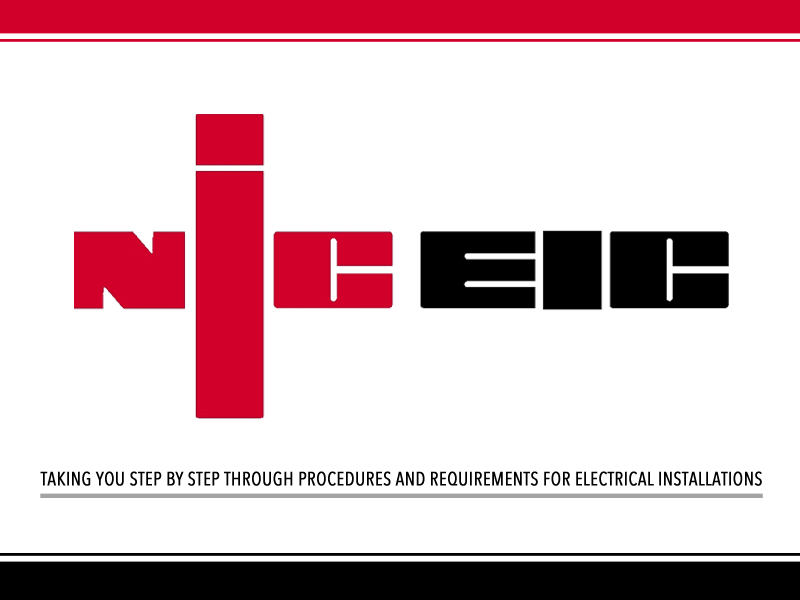
The technical team at NICEIC & ELECSA provide guidance to the contractor when testing RCDs installed to provide additional protection having a 0.25 A (250 mA) residual operating current characteristic.
Chapter 64 of the 18th Edition ( BS 7671 ) outlines the requirements and procedures that should be followed during initial verification or periodic testing and the need to compare the disconnection times obtained from such testing with the relevant disconnection times of Chapter 41 of BS 7671 .
However, it has become apparent that some Type A RCDs of rating of 30 mA or less are manufactured such that the maximum break (tripping) time (40 ms) is achieved at a current of 0.25 A (250 mA) rather than at 5 I Δn (150 mA for a 30 mA RCD).
This change seems to have caused some confusion and also difficulties in terms of verification in the field.
Information from the product standard The requirements for RCCBs and RCBOs for household and similar use are in given in BS EN 61008-11 and BS EN 61009-12 respectively.
Limit values of break time and non-actuating time, in seconds, for alternating residual currents (rms) for type AC and A RCCB are given in Table 1 of BS EN 61008-1 and in Table 2 of BS EN 61009-1 for RCBOs.
Note a. to both tables states that the manufacturer may choose a value of either 5 I Δn or 0.25 A (250 mA) as the residual operating current required to achieve a disconnection of 0.04 s for a ‘general’ type RCD. A number of manufacturers have now chosen to adopt 0.25 A for their products.
The problems It has been reported that contractors have experienced difficulties when testing 30 mA RCDs having a 0.25 A residual operating current characteristic. These difficulties seem to stem from the devices being tested at a current of 150 mA, rather than the necessary 250 mA (0.25 A), based on the assumption that using a test current of 5 I Δn will always be sufficient to cause the device to operate within the required time (0.04 s). This is not the case.
The note to Regulation 643.8 of BS 7671 which gives the requirements for the verification of an RCD to provide additional protection states that:
NOTE: Effectiveness is deemed to have been verified where an RCD meeting the requirements of Regulation 415.1.1 disconnects within 40 ms when tested at a current equal to or higher than five times its rated residual operating current.
It must be recognised that this guidance was written before the issue with verification of RCDs designed using 0.25 A residual operating current characteristic came to light.

It is reasonable, therefore, to use a test current higher than the ‘trip rating’ of an RCD regardless of the application of the RCD.
However, clause 4.2 of BS EN 61557-63 , the standard for RCD test instruments, specifies that ‘the measuring equipment shall be capable of indicating whether the fault voltage at the rated residual (operating) current of the protective device is less than or equal to the conventional touch voltage limit’.
This requirement is met in many RCD test instruments by conducting a short duration pre-testing check conducted at half the rated residual operating current selected on the instrument.
Where this is the case, this will invariably result in a failure of this check, as half of even the next standard rating (10; 30, 100, 300, 500 mA) above that of the actual RCD under test will always exceed its rated residual operating current.
The failure of this pre-test check will be indicated by the display of ‘TRIP’ or similar on the instrument’s screen. This will mean that trying to test an RCD by selecting a higher rating on a test instrument having only pre-set values of RCD rating employing this self-test method will not be feasible.
Some RCD test instruments however, have an adjustable residual operating current range allowing a value of 250 mA to be set, eliminating the above issue.
Where there is any doubt about how to use a particular RCD test instrument to verify an RCD designed to operate at 0.25 A the instrument manufacturer should be consulted.

● inspected visually to confirm that it has a rated residual operating current ( I Δn ) not exceeding 30 mA as required by Regulation 415.1.1, and ● tested using a suitable instrument.
Prior to carrying out testing, the test instrument should be set for the appropriate RCD ‘type’.
The person carrying out the testing must identify the operating characteristic of the RCD to determine whether the device should be tested at a current greater than or equal to either 5 Δn or 0.25 A as appropriate.
Neither BS EN 61008-1 nor BS EN 61009-1 requires an indication of the operating characteristic to be displayed or visible when the device is installed. It may be necessary therefore to refer to manufacturer’s data to determine this information.
To aid those carrying out testing, a number of manufacturers of devices employing the 0.25 A characteristic are now providing an advisory label explaining this which can be affixed inside the lid of the consumer unit or distribution board in which the RCD is installed.
The testing should be carried out in both the positive and negative half-cycles and the result obtained in each case should not exceed 40 ms; the greater of the two results obtained should be recorded in the appropriate place on the schedule of test results.
Summary When verifying whether an RCD can provide additional protection care must be taken to ensure that the device is tested at a test current appropriate to the operating characteristic to which the device was designed.
This may make it necessary to refer to manufacturer’s data relating to the RCD under test and, in many cases may mean that the test instrument manufacturer may need to be consulted to determine how best to configure the instrument prior to testing.
Key references * 1 BS EN 61008-1: 2012+A12: 2017. Residual current operated circuit-breakers without integral overcurrent protection for household and similar uses (RCCBs).
* 2 BS EN 61009-1:2012+A12:2016. Residual current operated circuit-breakers with integral overcurrent protection for household and similar uses (RCBOs).
* 3 BS EN 61557-6: 2007 Electrical safety in low voltage distribution systems up to 1,000 V a.c. And 1,500 V d.c. – Equipment for testing, measuring or monitoring of protective measures – Part 6: Effectiveness of residual current devices (RCD) in TT, TN and IT systems.
Get more details about NICEIC registration by clicking here
Related posts

Codebreakers #72
Made 2 measure: “i’m struggling to cope with all the different requirements using my present test kit” – is there a solution.

Using metallic armouring of a cable as a protective conductor | NICEIC

The essentials of client handover documentation | NAPIT

Dr Zzeus Q&A: How do you take an insulation reading on a fire cable?

Ask Ovia: Why are modern vapour-proof fittings not designed to fit onto conduit boxes?

Protective multiple earthing (PME) earthing facility | NICEIC

USB socket-outlets and the requirements for insulation resistance testing | Scolmore

ELECTRICAL DISCONNECTION TIMES

We are sometimes asked why the Wiring Regulations have disconnection times for electrical circuits.
And what is the purpose of knowing how quickly a fuse or circuit breaker should disconnect an electrical circuit during a fault.
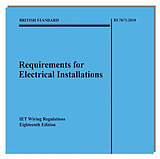
The permitted time to disconnect from the electrical source and to make safe the circuit is very much dependent upon the voltage of the circuit and a few other factors. It is all about ensuring that an electrical shock is survivable by an average, healthy adult.
We will be using information and numbers from the Wiring Regulations, BS7671 18th Edition.
DISCONNECTION TIMES
The disconnection time, the time taken for a circuit breaker to cut off the electrical supply during a fault is a big factor in someone surviving an electrical shock. The bigger the voltage, the bigger the danger of injury or death, and as you will see, as the voltage increases, the time to disconnect becomes more critical. The quicker that a circuit can disconnect the supply during a fault, the safer the circuit is.
Once we know what the disconnection time should be for safety, according to the regulations, then we can use the tables in the Wiring Regulations to determine what the maximum Zs or loop impedance is for different circuits. And if our circuit meets the requirements for Zs, or loop impedance as it is called, then we should be confident that it will meet the required disconnection times. The lower the Zs of the circuit, the greater the fault current that flows and the quicker the disconnect times.
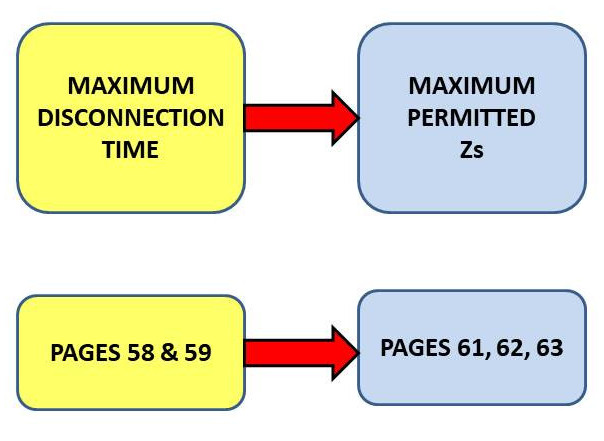
So now that we know why we have disconnection times, where do we get the information from?
Let’s start on page 58 of the 18th Edition Wiring Regulations book to determine the disconnection times and then we can look at pages 61 onwards to find the maximum Zs values.
On page 58 you will find Regulation 411.3.2.2
This tells us that we should use the disconnection times in TABLE 41.1 on page 59 for FINAL CIRCUITS
with a rated current not exceeding 63 amps for a circuit that has one or more sockets
or not exceeding 32 amps for a circuit supplying fixed equipment only.
FINAL AND DISTRIBUTION CIRCUITS
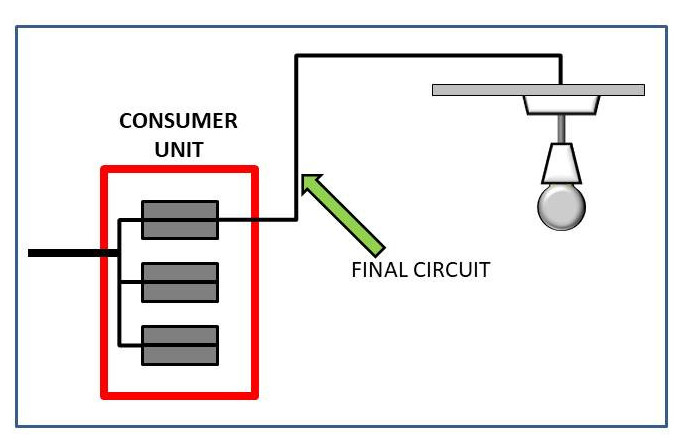
The next question is – What is a FINAL CIRCUIT
Imagine a lighting circuit in a house
The cables that leave the consumer unit and go to the luminaires are the last part of the journey for the electricity from when it left the power station to the point of use, in this case the light.
That piece of cable in the house is the final part of that journey. There are no more fuses or consumer units, this is the FINAL leg. This is a FINAL circuit.
The sockets are the same – a FINAL CIRCUIT.
So is the shower, the cooker and any other circuit that leaves the consumer unit and goes just to the points of use; they are all a FINAL CIRCUIT.
Just to clear up any confusion, a final circuit that includes fused connection units, or fused spurs as they are sometimes called, with BS1362 fuses of 13A or less is still a final circuit.
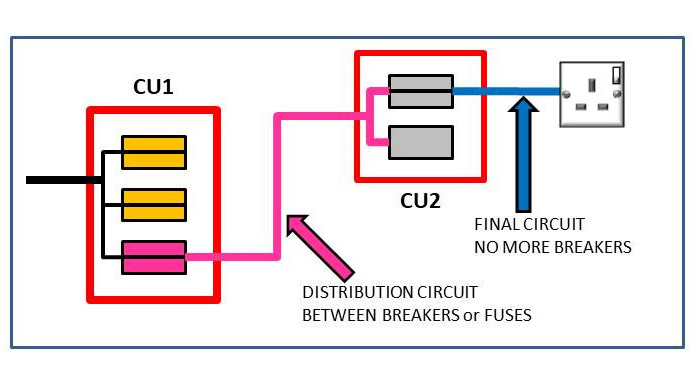
Now suppose that we take a cable from the consumer unit and run it into the garage and terminate this into a second consumer unit to supply sockets and lights in the garage.
This cable that connects the two consumer units is NOT a FINAL CIRCUIT as there is another set of circuit breakers to go through. This is what we call a DISTRIBUTION CIRCUIT.
It is DISTRIBUTING electricity from one consumer unit to another consumer unit, or from a distribution board to another distribution board or consumer unit.
The cables leaving the second consumer unit and going to the sockets or lights are FINAL CIRCUITS as before as they do not have any more circuit breakers to pass through.
So, final circuits – the last piece of cable to the various points of use
Distribution circuits – there are more circuit breakers down the line
Consumer units and distribution boards can contain both Final and Distribution circuits.
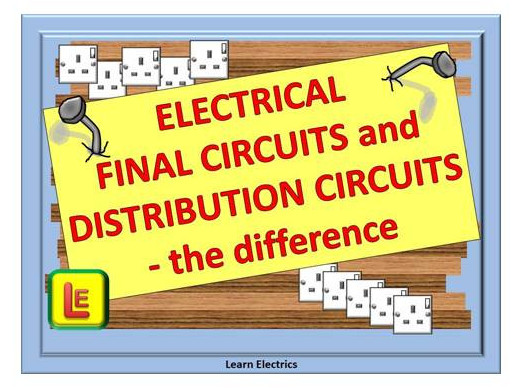
If you want to know more about final and distribution circuits we have a great video on YouTube called
ELECTRICAL FINAL CIRCUITS AND DISTRIBUTION CIRCUITS.
We will leave a link at the end of this article
FINAL CIRCUITS
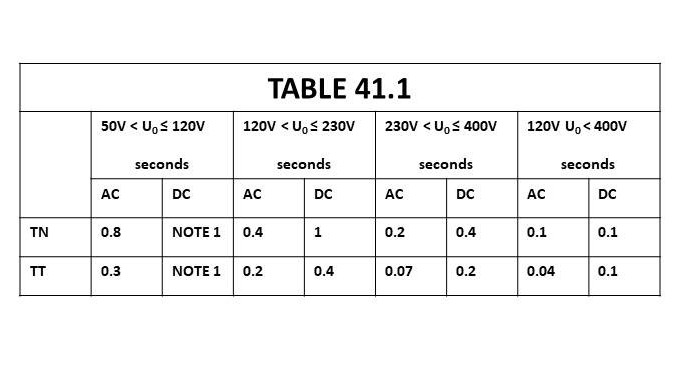
If the circuit meets the previously mentioned Regulation 411.3.2.2 then …
it will be a final circuit
and it will not exceed 63 amps for a circuit with sockets
nor will it exceed 32 amps for a circuit with fixed equipment only
And the Regulations tell us to use Table 41.1 on page 59 to determine the required maximum disconnection times.
USING TABLE 41.1

We are going to use TABLE 41.1 now for a few examples of circuits that DO meet the Regulation above.
First of all, let’s take a look at Table 41.1 and see how the table works and how we can use the information to arrive at the disconnection time that will help us to determine the Zs value that we should compare our actual test results against.
On the left of the table, number 1 and highlighted in red here, we have a choice of earthing system
either TN for TN-S or TN-C-S systems
or TT for those systems using earth rods or similar.
At the top of the table, numbered 2, we have four voltage ranges to choose from and it is important to choose the correct range. Within each range we have a further choice of AC voltages or DC voltages.
The bottom part of the TABLE, numbered 3, will give the disconnection time in seconds.
There are two entries here, numbered 4, that tell us to look at NOTE 1 for this table.
Note 1: Because this is a DC voltage and the maximum voltage for this range does not exceed 120 volts it falls into voltage Band One. This voltage band is extra low voltage and does not require protection to be provided against electric shock. The Wiring Regulations assume that at 120 volts DC you are unlikely to receive a fatal electric shock.
U0 WHAT IS IT?
Let us return to the voltage ranges at number 2 on the table above, and as an example let’s look at the range 120 volts to 230 volts.
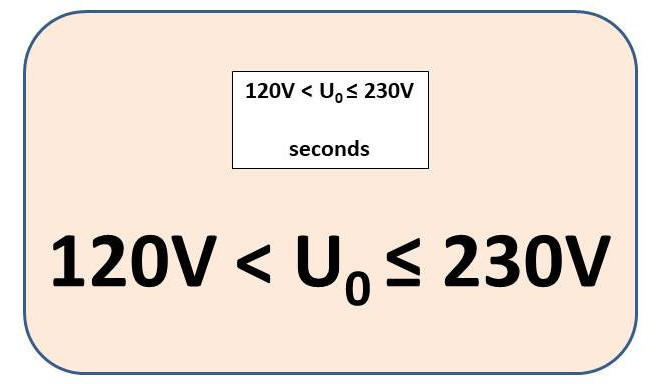
The range uses some symbols that we must pay proper attention to.
U0 (pronounced U zero) is the nominal voltage to earth. In a domestic property U0 is the nominal voltage between LINE and EARTH which we call 230 volts. It is NOT the voltage you measure, it is the assumed voltage, the nominal voltage.
We always use the nominal 230 volts for all of our calculations even if the circuit measures 240 volts.
The symbol “<” means greater than and the symbol “≤” means equal to or less than.
Looking at this arrangement of symbols, it is saying to us
U0, the nominal voltage between line and earth, is greater than 120 volts and equal to or less than 230 volts.
Let us use the Table to work out a few examples.
Starting with Example 1
A domestic property is fed by a 230 volt TN-S system, what is the disconnection time?
Looking at the table we can find the row TN for a TN-S system on the left
At the top choose the voltage range 120 to 230 since our nominal voltage does not exceed 230 volts.
It is AC so choose the correct column.
Where the column and row meet is the answer, here in blue, it is 0.4 seconds.
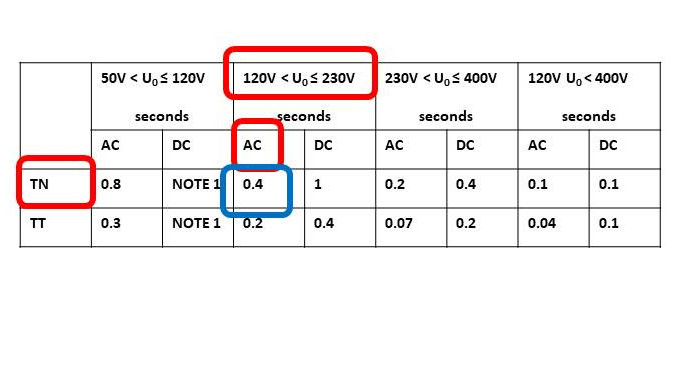
Example 2 is another domestic property but this time a TT system.
First we choose the row for a TT system
Next we can choose the voltage range 120 to 230 again
It is an AC circuit and where the two cross is our answer 0.2 seconds.
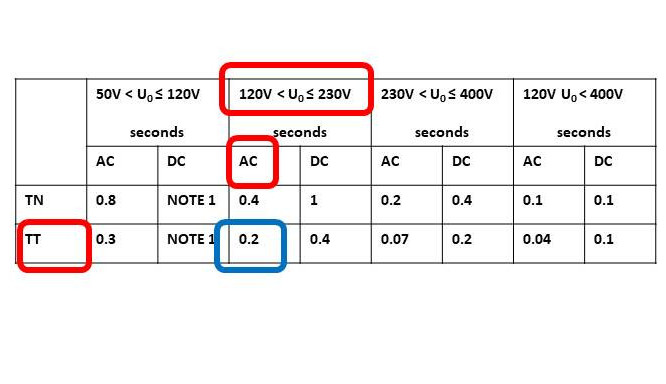
This example, number 3 is for a commercial property fed by a 3 phase 400 volt TN-C-S system.
400 volts is the voltage between LINES and this is called UL not U0
U0 is calculated by dividing the LINE TO LINE (UL) 400 volts by the square root of 3 which is 1.732
Calculating this, 400 divided by 1.732 will give us 230.9 volts which we round DOWN to 230V
So for a 400 volt 3 phase system, U0 is 230 volts
The rest of the calculation is the same as before
Choose a row, choose a voltage range and the disconnection time is 0.4 seconds.

Last one, example number 4
Another commercial property but this time with a 440 volt TN-C-S system.
First calculate U0 again. This time the LINE TO LINE voltage is 440 volts.
440 divided by 1.732 gives us 254 volts.
254 volts puts us in the voltage range greater than 230 volts but less than or equal to 400 volts.
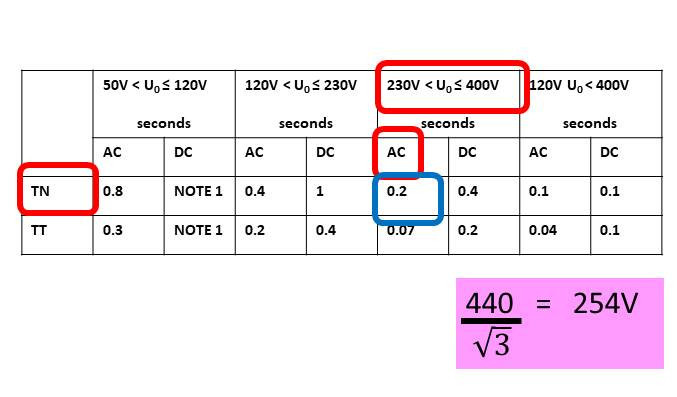
CIRCUITS THAT ARE NOT FINAL CIRCUITS
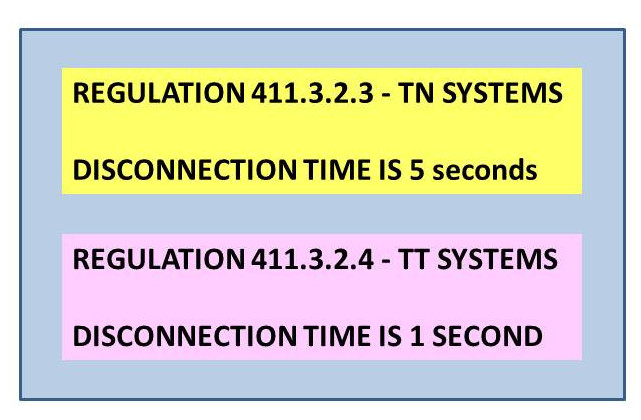
Now we can look at circuits that DO NOT meet Regulation 411.3.2.2
A circuit that is NOT a FINAL CIRCUIT
OR it is a circuit with one or more sockets, and the circuit is greater than 63 amps
OR it is a circuit rated above 32 amps supplying fixed equipment only
In this case, the disconnection time is very easy
If it is a TN system Regulation 411.3.2.3 applies
If it is a TT system then Regulation 411.3.2.4 applies
Regulation 411.3.2.3 for TN systems tells us the disconnection time for any TN-S or TN-C-S circuit that does not meet 411.3.2.2 or is a distribution circuit is 5 seconds regardless of the voltage
Regulation 411.3.2.4 for TT systems tells us the disconnection time for any TT circuit that does not meet 411.3.2.2 or is a distribution circuit is 1 second regardless of the voltage
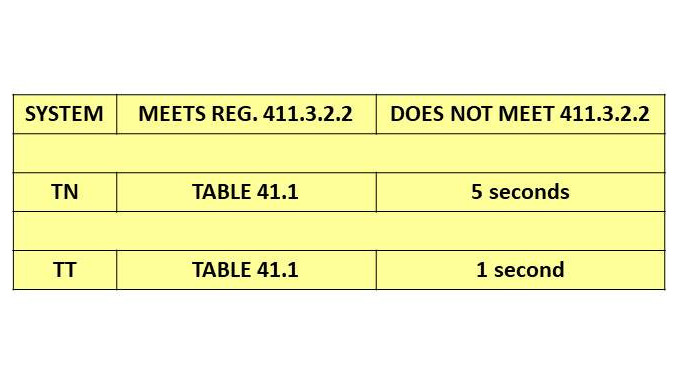
So it really is a quite simple exercise, is it a final circuit that meets Regulation 411.3.2.2, yes or no, is it a TN system or a TT system, yes or no and here we have put the last few slides into one table.
If Regulation 411.3.2.2 is met then we must use TABLE 41.1
If Regulation 411.3.2.2 is NOT met then we must use 5 seconds for TN systems and 1 second for TT systems.
FINDING Zs VALUES
Now that we know the disconnect times we can find the maximum Zs for the circuit, and it is Zs that we test when completing our electrical certificates. If our circuit does not exceed the maximum Zs value then it is assumed that it will also not exceed the maximum disconnection time.
CIRCUIT BREAKERS & RCBOs
First, let us look at TABLE 41.3 on page 62 of the WIRING REGULATIONS
The top of the table tells us that this table is for BSEN 60898 CIRCUIT BREAKERS and BSEN 61009-1 RCBOs and it also tells us that it is for 0.4 second disconnection times which are final circuits and also for 5 second disconnection times which generally implies distribution circuits.
It is the same table for any circuit using BSEN 60898 CIRCUIT BREAKERS and BSEN 61009-1 RCBOs
That makes it easy, all the information is on the same page. Make sure that you select the correct part of the table for the Type B, Type C or Type D breakers.
Now we can look at table 41.3 on page 61.
This is for fuses and specifically for 0.4 second times and this again implies FINAL CIRCUITS
Notice that fuse sizes shown do not go past 63 amps on his table as you would expect.
Make sure you are looking at the correct type of fuse, for example is it a BS88-2 or a BS88-3, they are on the same page, on the same table, they are next to each other but they have different Zs values. Choosing the wrong Zs could impact on the required disconnection time.
On page 63 we find table 41.4
This is for fuses again but specifically for DISTRIBUTION CIRCUITS with 5 second disconnection times
On Table 41.4 the fuse sizes do in fact go beyond 63 amps, and this is correct for this table.
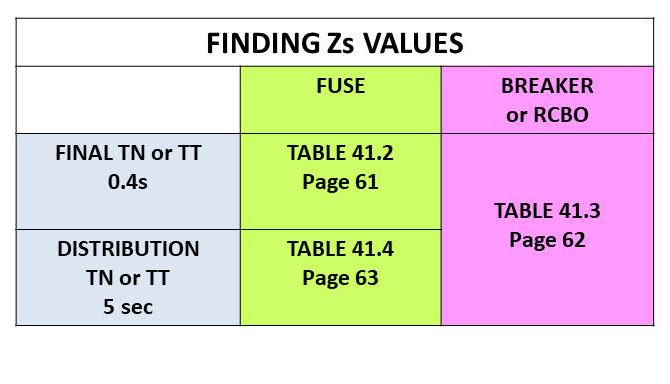
The table shown here should help you to visualise this.
Decide if it is a Final or Distribution circuit on the left and choose a row.
If it is a fuse make your selection in the green column and find the Zs in the appropriate table shown, either 41.2 on page 61 or 41.4 on page 63
If it is a circuit breaker or RCBO use table 41.3 on page 62 to find the Zs
TABULATED Zs & MEASURED Zs
These tables all show what are called tabulated figures. They are a table of figures that have been compiled from data in Appendix 3 of the Wiring Regulations and have had an allowance made for voltage fluctuations.
But an adjustment for temperature variations has not been made and we must find the measured value ourselves by applying the 80% rule or consult Table B6 in the On-Site Guide for example.
When on-site we need to know the measured values; when we measure something with our test meter, what figure should we be comparing it to directly.
To find the measured values multiply the numbers for Zs in the Wiring Regulations by 0.8
This is what we call the 80% rule and this is the Zs you should measure with your test meter.
Tabulated value x 0.8 = Maximum permitted measured value
_____________________________________________________________________________
We hope that you found this article from Learn Electrics both useful and enjoyable and that you have added more knowledge to your mental toolbox.
We also have a very active YouTube channel.
Type in LearnElectrics all one word, into the YouTube search bar and you will have access to all our videos on many electrical topics.
There is a companion video to this article on YouTube called
ELECTRICAL DICONNECTION TIMES
And this can be found by using the following link …
https://www.youtube.com/watch?v=14XPKfUaDdI
If you want to view our video
ELECTRICAL FINAL CIRCUITS AND DISTRIBUTION CIRCUITS
then please follow this link
https://www.youtube.com/watch?v=Jsqx7b9VdyM
To view all of our videos click the link below
https://www.youtube.com/channel/UCYaJQnpO4XAp0yCgqzMkmfA
Thank you, and we hope to see you again very soon.
Leave a Reply Cancel reply
Your email address will not be published. Required fields are marked *
Save my name, email, and website in this browser for the next time I comment.
Residual current selectivity
How to get selectivity between residual current protection devices (RCDs)
With its many functions and types, the residual current circuit-breaker can be defined as follows: a device sensitive to earth currents, able to open an electric circuit within a certain time when the current to ground exceeds the preset value. It is used to protect people and things against direct contacts (a device with high sensitivity, it is an additional protection), indirect contacts, and loss of insulation.
The professional rule for the electrical installation always imposes, except for special plants, the presence of an earthing system, both in civil and industrial buildings. Furthermore, the Standard IEC 60364 makes the use of a residual current circuit-breaker compulsory in many cases for protection of people, giving prescriptions referring to the trip time and currents in relation to the installation voltage, to the existent distribution system, and to the places of installation.
Good protection of the installation should provide:
- A main residual current type of circuit-breaker so as to ensure protection against the faults that may occur between the main circuit-breaker and the distribution;
- Protection of each individual shunt with a residual current device.
Thus, there is the need to study carefully the selection of devices suitable to guarantee selectivity, and prevent an earth fault in any point of the distribution circuit from causing downtime for the whole installation. In general, two residual current devices are selective for each current value if their trip zones do not overlap. This condition is obtained by respecting the following points:
- The residual current trip threshold of the device on the supply side must be higher than or equal to double the residual current trip threshold of the device on the load side: I∆n Supply side ≥ 2xI∆n Load side This relationship is necessary for taking into account the concept of rated no trip residual current, which is the maximum current value for which the residual current circuit-breaker definitely does not trip. The Standards indicate a current value of I∆n/2 and, below this value, the device does not have a definite behavior, i.e. it may trip just as it may not trip.
- The minimum no trip time of the circuit-breaker on the supply side, for each current value, must be higher than the maximum trip time of the circuit-breaker on the load side: T minsupply > T totload
Protection against earth faults can be realized using the function G available on the electronic trip units installed onboard the moulded-case or air circuit-breakers. The trip characteristics can be adjusted in current (from 0.2 to 1xIn) and in time (inverse or definite time), depending on the different versions. Realizing protection against indirect contact with this type of function requires a careful analysis of the distribution system and of the value of the earth fault current.
With Emax 2 circuit-breakers, it is possible to realize zone selectivity for function G according to the same philosophy described for function S. This makes it possible to reduce the trip times between two residual current protections in series, increasing the margin of safety for any fault on the load side of the supply-side circuit-breaker, since its trip time is not as high as it should have been to obtain selectivity towards the load side with the classic method for time selectivity.
Here is an example of a network where residual current selectivity on 3 levels must be realized. Considering the residual current trip units available:
RC Inst (Tmax XT1-XT3)
RC222 (Tmax T4-T5)
To obtain selectivity the following device can be used :

Learn more about

- Middle East and Africa
- Asia and Oceania
- Austria - German
- Belgium - Dutch | French
- Bulgaria - Bulgarian
- Croatia - Croatian
- Czech Republic - Czech
- Denmark - Danish
- Estonia - Estonian
- Finland - Finnish
- France - French
- Germany - German
- Greece - Greek
- Hungary - Hungarian
- Ireland - English
- Italy - Italian
- Latvia - Latvian
- Lithuania - Lithuanian
- Luxembourg - French
- Netherlands - Dutch
- Norway - Norwegian
- Poland - Polish
- Portugal - Portuguese
- Romania - Romanian
- Russia - Russian
- Serbia - Serbian
- Slovakia - Slovakian
- Slovenia - Slovenian
- Spain - Spanish
- Sweden - Swedish
- Switzerland - French | German | Italian
- Turkiye - Turkish
- United Kingdom - English
- Argentina - Spanish
- Aruba - Spanish
- Bolivia - Spanish
- Brazil - Portuguese
- Canada - English | French
- Chile - Spanish
- Colombia - Spanish
- Costa Rica - Spanish
- Dominican Republic - Spanish
- Ecuador - Spanish
- El Salvador - Spanish
- Guatemala - Spanish
- Honduras - Spanish
- Mexico - Spanish
- Panama - Spanish
- Peru - Spanish
- Puerto Rico - Spanish
- United States of America - English
- Uruguay - Spanish
- Algeria - English | French
- Angola - English | French
- Bahrain - English | French
- Botswana - English | French
- Cameroon - English | French
- Côte d'Ivoire - English | French
- Egypt - English | French
- Ghana - English | French
- Israel - Hebrew
- Jordan - English
- Kenya - English | French
- Kuwait - English
- Lebanon - English
- Madagascar - English | French
- Mali - English | French
- Mauritius - English | French
- Morocco - English | French
- Namibia - English | French
- Nigeria - English | French
- Oman - English
- Pakistan - English
- Palestine - English
- Qatar - English
- Saudi Arabia - English
- Senegal - English | French
- South Africa - English
- Tanzania - English | French
- Tunisia - English | French
- Uganda - English | French
- United Arab Emirates - English
- Zambia - English | French
- Zimbabwe - English | French
- Australia - English
- Bangladesh - English
- China - Chinese | English
- India - English
- Indonesia - English
- Japan - Japanese
- Kazakhstan - Russian
- Malaysia - English
- Mongolia - Mongolian | English
- New Zealand - English
- Philippines - English
- Singapore - English
- South Korea - Korean
- Sri Lanka - English
- Taiwan (Chinese Taipei) - Chinese - Traditional
- Thailand - English
- Vietnam - English
abb.com privacy settings
Our website uses cookies which are necessary for running the website and for providing the services you request. We would also like to set the following optional cookies on your device. You can change these settings any time later by clicking "Change cookie settings" at the bottom of any page. For more information, please read our privacy notice.
We collect statistics to understand how many visitors we have, how our visitors interact with the site and how we can improve it. The collected data does not directly identify anyone.
We store choices you have made so that they are remembered across visits in order to provide you a more personalized experience.
Your browsing behavior is tracked across websites by advertising and social network service providers. You may see tailored advertising and content on other websites based on your browsing profile.
Preferences
Advertising and tracking
Popular links
- ABB Connect
- ABB Electrification
- Where to buy
- Mission to Zero
- ABB Ability
- Supplying to ABB
- Customer events
- Investor events
- Media events
- Case Studies
- Latest Jobs
- Does It Comply
- Regulation News
- Newsletter archives
- Electrical Reference Apps
- Technical Topics Overview
- Cables, Wiring and Wiring Accessories
- Electrical Control
- Distribution Equipment including Cable Management
- Energy Efficiency and Sustainability
- Fire, Safety and Security
- Electrical Heating, Ventilation & Control
- Installation Tips
- Regulation and Legislation
- Smart Homes & Building Automation
- Testing Tools and Equipment
- Electric Vehicle Infrastructure
- Internet of Things
- Q&A of the Day
- Ask an Expert
- Community questions
- Interactive videos
- Product Finder
- Training Webinars
- Catalogues Overview
- PDF Catalogues

- Premium Partners
- SCHNEIDER ELECTRIC
- Manufacturers
- Ampere Energy
- Aurora Lighting Group
- BG Electrical
- British Cables Company
- Brother UK Ltd
- Di-LOG Group
- Emergi-Lite
- Kewtech Corporation
- KIDDE SAFETY EUROPE LTD
- Luceco Lighting’s
- MARSHALL-TUFFLEX LTD
- Martindale Electric
- Mita, powered by Wibe Group
- MK ELECTRIC
- Rointe Heating
- Scolmore Group
- VOLEX ACCESSORIES
- Wholesale Distributors
- City Electrical Factors
- Expert Electrical
- KEW ELECTRICAL
- Phase Electrical
- Member News
- Login with Google
- Forgot password?
- You are here:
- Q&A of the Day >
- Q & A of the Day – Is 300mA RCD protection required for...

Q & A of the Day – Is 300mA RCD protection required for this glasshouse installation?

Is 300mA RCD protection required?
Question: I plan to fit a three-phase distribution board into a glasshouse. The board will supply six separate heaters, each of which has a three-phase motor for fan operation. There will also be three off three-phase motors for ventilation. All socket outlets will have 30mA RCD protection, by means of an RCBO fitted into the distribution board.
The installation is on a TT earthing system. I plan to fit a 300mA S-Type RCD on the supply to the three-phase distribution board, then - if possible - fit a second 300mA RCD to protect the three-phase distribution board. Note that the earth spike is below 167 ohms, so a 300mA RCDs should operate OK.
Basically, is this level of protection acceptable for a glasshouse environment - given the need for unwanted RCD tripping? Does BS7671 require 30mA RCD protection for all circuits wired in an environment such as a glasshouse where conditions are damp?
Also, because the loads are mainly inductive and may cause unwanted tripping of a 30mA RCD, would it be possible to fit a 300mA RCD?
Answer: From your explanation it would appear you will be compliant. The 300mA RCD should be of the S type or have a time delay to avoid nuisance tripping. In addition, all live conductors should be isolated - i.e. the three line conductors and the neutral conductor.
Note that all equipment installed in the glasshouse should be IP44 rated. BS 7671:2008 Section 705 deals with agricultural and horticultural premises. Further information is also available in Guidance Note 7.
To see many more Q & A in Voltimum UK's Experts Area, please click on the link:
If you want to leave your comment, please register or log in .
JOIN OUR NEXT WEBINAR
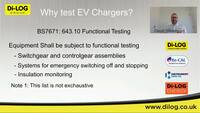
Technical Articles
Dangerous compatibility, external influences, approved document m – access to and use of buildings, the energy predicament: fuelling transformation in the energy market, all your fire protection solutions under one roof, related stories.
- Q & A of the Day- Does this machine outdoors need MCB...
- Q & A of the Day- Can I use meter tails for this...
- Q & A of the Day- Will this oven need RCD protection?
- Q & A of the Day – Must I install an RCD to protect...
- Q & A of the Day – Should I run a separate 10mm earth...

Related topics
- © 2002-2024 Voltimum, www.voltimum.com
And here's some amazing content. It's very engaging. right?
Please Login or Register
- Yekaterinburg
- Novosibirsk
- Vladivostok

- Tours to Russia
- Practicalities
- Russia in Lists
Rusmania • Deep into Russia
Day trip to Suzdal from Moscow: transport, sights, maps and tips

DAY TRIP TO SUZDAL
Suzdal is one of the most popular destinations on the Golden Ring and the whole city is often described as an open-air museum. The city has no railway station and practically no heavy industry, meaning that is has preserved its provincial charm and a great deal of architectural monuments.

From Moscow, Suzdal is not as easy to get to as Sergiev Posad (the closest Golden Ring city to the capital) but it is worth going the extra distance as Suzdal provides more of a contrast from Moscow. If you make use of high-speed trains it is possible and not too demanding to visit for even just a day, but of course spending the night there is recommended to soak in the atmosphere or to combine it with a visit to neighbouring Vladimir. As the city is a very popular tourist destination you will have no problem finding a cafe or guesthouse there. There is practically no public transport in the city, but the city is small and most sights are located relatively close to each other.
Getting There and Back
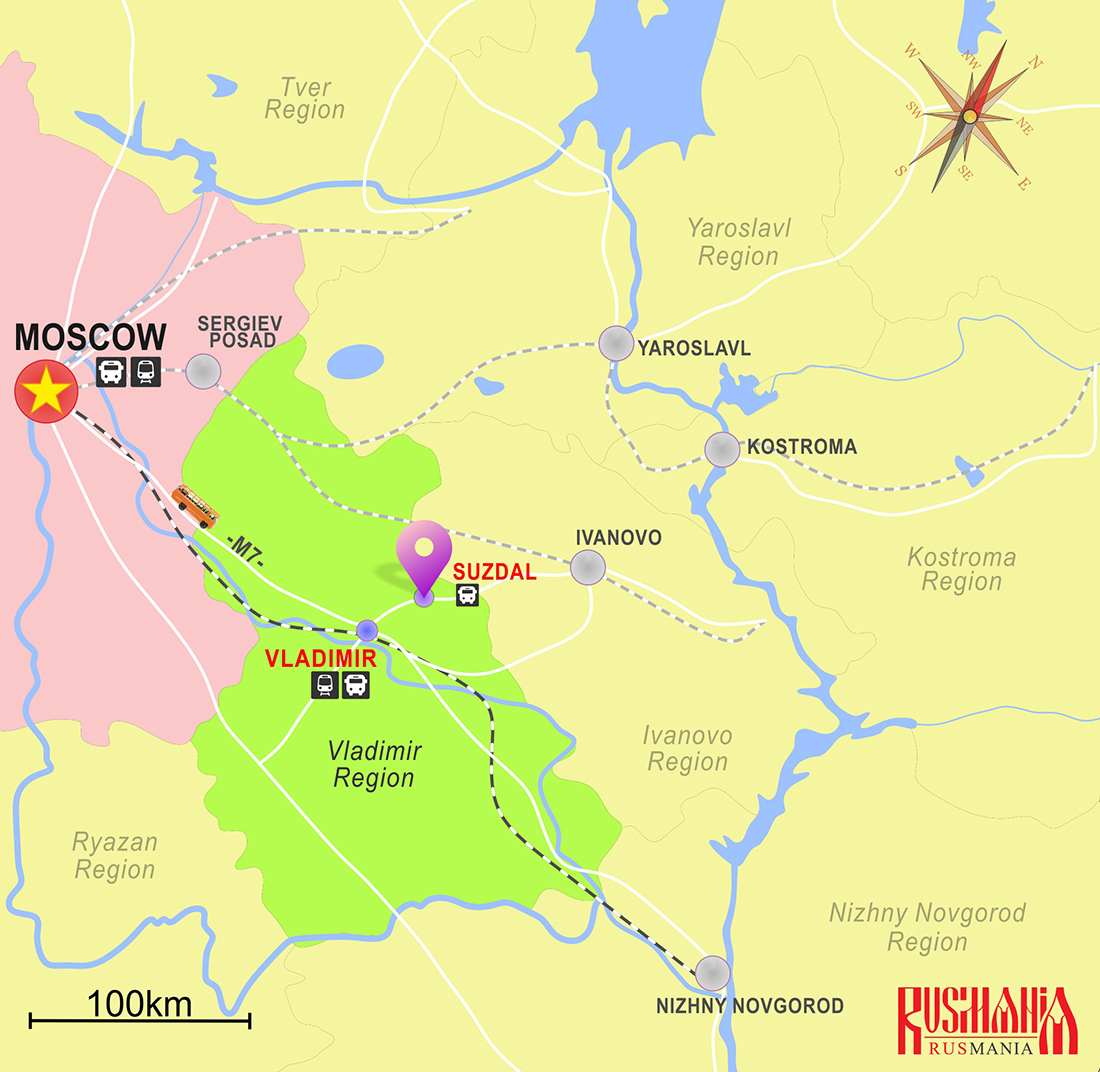
Via Vladimir

Direct to Suzdal
Buses directly to Suzdal leave from Moscow’s Schyolkovsky Bus Station. There are about 9 buses a day and it takes around 4½ hours depending on traffic. The buses stop at Vladimir too. Using this option will mean a rather exhausting day trip.
Orientation and Main Sights

Suzdal is a relatively small city and it is not difficult to walk around the city to see most of the sights.

The main road in the city is Ulitsa Lenina which runs north across the whole city.

The main sights of Suzdal are located either on or just off this road, including the two main sights: the Suzdal Kremlin in the south and the Spaso-Yevfimiev Monastery in the north.

More information about Suzdal can be found on our Suzdal pages.
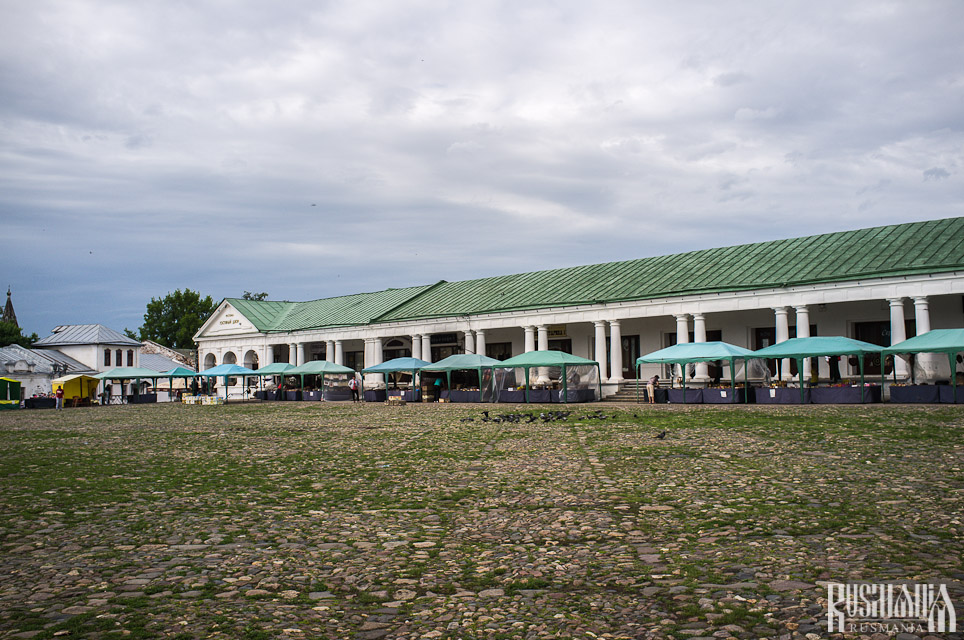
Suzdal is famous for its medovukha (mead) which is an alcoholic drink made out of honey. It can be drunk either hot or cold, meaning it perfect in both summer and winter, and you will find it on practically every menu in the city. There are various flavours of the drink available and even a non-alcoholic version. In addition to medovukha, you can find all traditional Russian souvenirs in the city and there is a big souvenir market on Torgovaya Ploschad.

Plan your next trip to Russia
Ready-to-book tours.
Your holiday in Russia starts here. Choose and book your tour to Russia.
REQUEST A CUSTOMISED TRIP
Looking for something unique? Create the trip of your dreams with the help of our experts.
- Moscow Tourism
- Moscow Hotels
- Moscow Bed and Breakfast
- Moscow Vacation Rentals
- Flights to Moscow
- Moscow Restaurants
- Things to Do in Moscow
- Moscow Travel Forum
- Moscow Photos
- All Moscow Hotels
- Moscow Hotel Deals
- Things to Do
- Restaurants
- Vacation Rentals
- Travel Stories
- Rental Cars
- Add a Place
- Travel Forum
- Travelers' Choice
- Help Center
Day trip to golden triangle, Vladimir, Suzdal.... - Moscow Forum
- Europe
- Russia
- Central Russia
- Moscow
Day trip to golden triangle, Vladimir, Suzdal....
- United States Forums
- Europe Forums
- Canada Forums
- Asia Forums
- Central America Forums
- Africa Forums
- Caribbean Forums
- Mexico Forums
- South Pacific Forums
- South America Forums
- Middle East Forums
- Honeymoons and Romance
- Business Travel
- Train Travel
- Traveling With Disabilities
- Tripadvisor Support
- Solo Travel
- Bargain Travel
- Timeshares / Vacation Rentals
- Central Russia forums
- Moscow forum

We'd like to go to Vladimir, Suzdal and some other areas if possible for a day.
We are budget tourist and would like to use public transportations touring on our own.
I need recommendations for planning the tour.
How can visit Suzdal from Vladimir train station?
Are the attrations easily accessible by bus or any other public means?
If someone can suggest a plan for a full day tour from morning to evening including when, where, how, cost etc. that would be greatly helpful.
Please help this poor tourist.
Thank you very much.

"golden triangle" - is the criminal drug zone in Asia
I fond the term "Golden ring" from a couple of tourist websites. The below is from Wikipedia,
You would know a drug zone but I meant Russian cities in my question. Please write if you only can help with my question. Thank you.
Sorry I meant gold ring, not triange

Just to set expectations, this is NOT simply some small ring of cities you can easily move around in 1-2 days...the Vladiimir/Suzdal trip would be VERY tight in one day, especially if you are intent on do-it-yourself". That is, while normally I am a fan of "do-it-yourself", getting all this done in one day - and with some reasonable "depth" might make you want to think twice about not using some local guide. At best, as stated, you would take the first train out and last one back from Vladimir, and then use bus or whatever to get back and forth from Suzdal...
Other cities are not really "on the way" - some that come to mind include Sergiev Posad, which is much closer but still takes time coming and going, and much further out Yaroslavl and Rostov...in the same direction, but a LONG train ride away...suggest you get your fill with Vladimir and Suzdal, there are quite unique, and different from each other.
One other thing...when are you going...if it is later fall, just be prepared for much shorter daylight hours...not so bad in September, but closer to December, quite short days...
I'll visit end of august. In case I want to do with tour agency. Are there tours available to book once Im there at hotels or tour agencies as day tours?
This topic has been closed to new posts due to inactivity.
- Train Booking Moscow to St. Peter Mar 29, 2024
- Union Pay debit card Mar 27, 2024
- Russian trying to book a hotel in Jerusalem Mar 14, 2024
- Dual Citizen Arrested in Russia Mar 12, 2024
- about clothes Feb 27, 2024
- NOTE - border crossing from Finland into Russia closed Feb 09, 2024
- Snow boots in Red Square Feb 04, 2024
- Travelling to Moscow & Murmansk with toddle in winter Feb 02, 2024
- Anyone traveling from London to Moscow this week ? Jan 27, 2024
- Booking accommodation Jan 11, 2024
- Traveling friends (Designers preferred) :) Jan 05, 2024
- Are shops and things closed during Christmas and New Week ? Dec 15, 2023
- Traveling to Eastern Russia Nov 17, 2023
- Travel to russia september 2023 tips welcome Oct 17, 2023
- Moscow to St Petersburg train or air?? 32 replies
- New Sapsan Express Train from Moscow to St Petersburg 18 replies
- New year's in moscow 8 replies
- Hop on Hop Off Bus Tour 5 replies
- How do you purchase Bolshoi Ballet tickets at a great price? 2 replies
- Select-a-room.com Are they legitimate? 3 replies
- Weather Moscow and St. petersburg in May 8 replies
- Night train to St Petersburg 3 replies
- ATM Access 12 replies
- Visa needed if on layover at Moscow Airport??????? 15 replies
Moscow Hotels and Places to Stay
- Where can I get initial answers to ANY question?
More From Forbes
There’s still time for a trip to see the total solar eclipse in ohio.
- Share to Facebook
- Share to Twitter
- Share to Linkedin
On Monday, April 8, 2024, a total solar eclipse will be visible within parts of North America. If weather is permitting and there aren’t cloudy skies, total visibility will start along Mexico’s Pacific Coast. In the United States, the path of totality, which is the narrow ribbon of places where the full eclipse can be viewed, goes from Texas to Maine. NASA is offering a map that shows the path of totality as well as a timetable of when the eclipse should appear in some of the major locations where it can be viewed.
This is a photo from the total solar eclipse in 2017 in Madras, Oregon.
If you have never experienced a total eclipse but want to do so, it’s not too late to schedule a last-minute trip to enjoy it. After all, we’re not expected to have another total eclipse that’s visible in the U.S. for nearly a decade , and that one will only be visible from the U.S. in the state of Alaska. Beyond that, the next one is in 2044.
This 2024 eclipse will be the first time a total solar eclipse is visible from Ohio in 208 years. Some places booked up for the eclipse months in advance. However, you can still plan a last-minute trip to some cool and sometimes overlooked destinations in the path of totality in Ohio that are just as much fun the most known cities.
One spot to consider is Mansfield, a charming city in the foothills of the Allegheny Plateau of the Appalachian Mountains. Spectrum News 1 reported that the eclipse will start in Mansfield at 1:57 p.m. EST and plunge the city into darkness when it reaches totality at 3:12 p.m. That cover of darkness should last for about 3 minutes, 16 seconds as the moon passes between the sun and Earth. It will conceal the sun from view completely during that time. The overall eclipse should be over at 4:27 p.m.
While thousands of visitors are already expected in this north central Ohio city and its neighboring Richland County villages for the eclipse, there is still some availability, and you’ll find dozens of fun ways to celebrate the eclipse while there. Many local venues have planned events and crafted special menus.
Best High-Yield Savings Accounts Of 2024
Best 5% interest savings accounts of 2024.
Here are some places in Mansfield where you can view or celebrate the total solar eclipse.
Yoga at the Ohio Bird Sanctuary
If you want to start your celebrations early in the day, the Ohio Bird Sanctuary will kick things off with Total Eclipse Yoga at 8:30 a.m. This class is led by the center’s director and will cost $10 per person.
Luminous Solar Eclipse Gathering at Mankind Murals Inc.
A pop-up art gallery and eclipse viewing party combine in a fun way in downtown Mansfield for this event at the Luminous City studio lot. Hosted by Mankind Murals Inc., the gathering at 88 North Diamond Street will showcase the eclipse-themed artwork of over a dozen local artists. A DJ will be playing fun music. There are planned patio games and selfie stations. A limited number of solar eclipse glasses will be provided on a first-come, first-served basis. They’ll also serve beer, wine and signature eclipse-themed craft cocktails with names like the Twilight Eclipse and the Screwball Eclipse.
Eclipse Viewing and More at the Snow Trails Ski Resort
From 9 a.m. to 5 p.m., you can hit the slopes, relax on the decks or patios, or tailgate at the Snow Trails Ski Resort to view the solar eclipse from this gorgeous resort. There are no overnight accommodations or parking here, so just plan to atten between the scheduled hours. They will have live music at The Snowflake Loft, and their onsite Lucky’s Cafeteria will be serving breakfast and lunch. The price of admission is $25 per car or $50 per larger RVs.
Eclipse Garden Party at the Kingwood Center Gardens
Eclipsed at the Estate is a celebration planned to take place from 10 a.m. to 7 p.m. at Kingwood Center Gardens. With its 47 acres of formal and woodland gardens, this viewing party will certainly remind you of the beauty of nature on earth and in the skies. A limited amount of certified viewing glasses will be available to guests. Educational activities are planned during the event, too.
Mansfield and Richland County offers dozens of other terrific spots for viewing the eclipse, too. Many are free to the public. Go to the Richland County eclipse viewing page for many of the sites you may want to consider.
If you want to plan a last-minute trip to view and celebrate the eclipse in the Mansfield area of Ohio, it’s a good idea to book hotels and other activities as soon as possible. Keep in mind that some events will sell out, so it’s important to call to confirm your attendance and whether you need a reservation and ticket.
When planning how and when you will attend different festivities, consider that there will likely be extremely heavy traffic on April 8. Rather than planning to leave your viewing location immediately after viewing, it’s a good idea to come early then hang out late. Make a day of it and enjoy yourself for a while to avoid the worst of the traffic jams.
- Editorial Standards
- Reprints & Permissions
Your last-minute guide to Monday's total solar eclipse

A total solar eclipse will cross North America on Monday , offering millions a rare opportunity to see afternoon skies temporarily darken as the moon blocks the face of the sun.
Tune into NBC News NOW as Lester Holt hosts a two-hour special at 2 p.m. ET Monday from Indianapolis Motor Speedway.
The eclipse's path fortuitously cuts across Mexico, 15 U.S. states and a small part of eastern Canada. In all other states in the continental U.S., viewers will be treated to a partial solar eclipse, with the moon appearing to take a bite out of the sun and obscuring part of its light.
Here’s everything you need to know about the rare celestial event.
What is a solar eclipse?
Solar eclipses occur when the sun, moon and Earth align. The moon passes between Earth and sun, temporarily blocking the sun’s light and casting a shadow on Earth.
A total solar eclipse is when the moon fully obscures the sun, whereas a partial solar eclipse means it blocks just a portion of the sun’s face.
Solar eclipses occur only with the new moon. Because the moon’s orbit around Earth is tilted, the three bodies don’t always line up in a way that creates an eclipse.
“Imagine if the moon’s orbit were in the plane of Earth’s orbit around the sun — if that were the case, then every new moon, you’d have a total solar eclipse and every full moon, you’d have a lunar eclipse,” Neil DeGrasse Tyson, director of the Hayden Planetarium at the American Museum of Natural History, told NBC News. “So, because things don’t always align, it lends to the rarity of the event and the specialness of the event.”
Where and when will the eclipse be visible?
This year’s eclipse will follow a slightly wider path over more populated areas of the continental U.S. than other total solar eclipses have in the recent past.
NASA estimates that 31.6 million people live within what’s known as the path of totality, where the total solar eclipse will be visible. An additional 150 million people live within 200 miles of the path, according to the agency.
The path travels through Texas, Oklahoma, Arkansas, Missouri, Illinois, Kentucky, Indiana, Ohio, Pennsylvania, New York, Vermont, New Hampshire and Maine. Tiny parts of Michigan and Tennessee will also be able to witness totality if conditions are clear.
After the eclipse crosses into Canada, it will pass over southern Ontario, Quebec, New Brunswick, Prince Edward Island and Cape Breton, at the eastern end of Nova Scotia.
Those outside the path of totality can still take part in the astronomical event by viewing a partial solar eclipse — visible throughout all 48 states of the contiguous U.S. — or a NASA livestream.
The timing, including how long totality lasts, depends on the location, but some spots will see the moon fully cover the sun for up to 4 minutes and 28 seconds.
Below is a list of timings for some cities along the path of totality, as provided by NASA . A number of other resources, including NationalEclipse.com and TimeandDate.com , can also help people plan.
- Dallas: Partial eclipse begins at 12:23 p.m. CT and totality at 1:40 p.m.
- Little Rock, Arkansas: Partial eclipse begins at 12:33 p.m. CT and totality at 1:51 p.m.
- Cleveland: Partial eclipse begins at 1:59 p.m. ET and totality at 3:13 p.m.
- Buffalo, New York: Partial eclipse begins at 2:04 p.m. ET and totality at 3:18 p.m.
- Lancaster, New Hampshire: Partial eclipse begins at 2:16 p.m. ET and totality at 3:27 p.m.

How to safely view a solar eclipse
It is never safe to gaze directly at the sun, even when it is partly or mostly covered by the moon. Special eclipse glasses or pinhole projectors are required to safely view solar eclipses and prevent eye damage. Failing to take the proper precautions can result in severe eye injury, according to NASA .
Eclipse glasses are thousands of times darker than normal sunglasses and specially made to enable wearers to look at the sun during these kinds of celestial events.
Sky-watchers should also never view any part of the sun through binoculars, telescopes or camera lenses unless they have specific solar filters attached. Eclipse glasses should not be used with these devices, as they will not provide adequate protection.
However, during the few minutes of totality, when the moon is fully blocking the sun, it is safe to look with the naked eye.

Beware of fake eclipse glasses. On legitimate pairs, the lenses should have a silver appearance on the front and be black on the inside. The manufacturer’s name and address should be clearly labeled, and they should not be torn or punctured. Check, as well, for the ISO logo and the code “IS 12312-2” printed on the inside.
If you don’t have eclipse glasses, you can make a homemade pinhole projector, which lets sunlight in through a small hole, focuses it and projects it onto a piece of paper, wall or other surface to create an image of the sun that is safe to look at.
All you need is two pieces of white cardboard or plain white paper, aluminum foil and a pin or thumbtack. Cut a 1- to 2-inch square or rectangle out of the center of a piece of white paper or cardboard. Tape aluminum foil over that cut-out shape, then use a pin or thumbtack to poke a tiny hole in the foil.
During the eclipse, place a second piece of white paper or cardboard on the ground as a screen and hold the projector with the foil facing up and your back to the sun. Adjusting how far you hold the projector from the second piece of paper will alter the size of the image on the makeshift screen.
What to look for while viewing the total solar eclipse
For people along the path of totality, there are some fun milestones to keep track of as the total solar eclipse unfolds.
As the eclipse progresses and the sun gets thinner in the sky, it will start to get eerily dark, according to Tyson.

When the last beams of sunlight are about to become obscured, look out for the “diamond ring effect”: The sun’s atmosphere will appear as an illuminated halo, and the last light still visible will look like the diamond of a giant ring.
As the sunlight decreases even further, an effect known as Baily’s beads will be created by the moon’s rugged terrain. Tiny “beads” of light will be visible for only a few seconds around the dark moon, as the last bits of sunlight peer through the moon’s mountains and valleys.
When the moon is fully blocking the sun, it is safe to remove eclipse glasses and look at the total solar eclipse with the naked eye.

Some lucky sky-watchers may even catch a glimpse of a comet .
Comet 12P/Pons-Brooks — nicknamed the “ devil comet ” because an eruption last year left it with two distinct trails of gas and ice in the shape of devil horns — is currently visible from the Northern Hemisphere as it swings through the inner solar system.
The comet can be seen in the early evenings by gazing toward the west-northwest horizon. During the eclipse, when skies darken during totality, it may be possible to see the comet near Jupiter, but its visibility will depend on whether it’s in the middle of an outburst and thus brighter than normal.
Most likely, all eyes will be on the alignment of the moon and sun.
“Most people won’t even notice,” Tyson said. “But if you know to look, it’s there.”
When is the next solar eclipse?
The next total solar eclipse will be in 2026, but it will mostly pass over the Arctic Ocean, with some visibility in Greenland, Iceland, Portugal and northern Spain. In 2027, a total solar eclipse will be visible in Spain and a swath of northern Africa.
The next total solar eclipse visible from North America will be in 2033, but only over Alaska. Then in 2044, a total solar eclipse will cross Montana, North Dakota, South Dakota, parts of Canada and Greenland.
The next total solar eclipse to cross the continental U.S. coast-to-coast in will occur in 2045. The path of totality for that eclipse will cut through California, Nevada, Utah, Colorado, New Mexico, Oklahoma, Kansas, Texas, Arkansas, Missouri, Mississippi, Louisiana, Alabama, Georgia and Florida.
Denise Chow is a reporter for NBC News Science focused on general science and climate change.
Lucas Thompson is a content producer for the NBC News Climate Unit.
Advertisement
U.S. Says Israel Has Agreed to Try to Reschedule Canceled Trip
Netanyahu’s office hasn’t confirmed it has any desire to make new plans.
- Share full article

By Zach Montague
reporting from Washington
- March 27, 2024
A White House spokeswoman said on Wednesday that the Israeli government had agreed to try to reschedule a visit by a group of officials whose trip to Washington to discuss a possible assault on a key southern city in Gaza was scrapped over the U.S. decision not to veto a U.N. resolution calling for an immediate cease-fire.
President Biden had asked Israel to send a delegation to Washington to discuss alternatives to a ground offensive in Rafah, the southern Gaza city where more than a million people have sought refuge. But Israel’s prime minister, Benjamin Netanyahu, called off the delegation’s trip at the last minute after being angered by the U.S. decision to abstain from a vote on the resolution at the U.N. Security Council on Monday.
“The prime minister’s office said that they want to reschedule this meeting so that we can talk about the Rafah operations,” the White House press secretary, Karine Jean-Pierre, told reporters on Wednesday. “We welcome that. And we’re going to work with their teams to make sure that happens.”
John F. Kirby, a White House spokesman, added on Thursday that the administration was working with the prime minister’s office and other Israeli officials to finalize a date for the rescheduled meeting. “We’re hoping that this meeting can be scheduled in person here in Washington as was the original plan,” he told reporters.
There was no immediate confirmation of a desire to reschedule from Mr. Netanyahu’s office, which, just hours before Ms. Jean-Pierre’s comments, had issued a statement denying reports that a meeting was back on. “Contrary to reports, the prime minister didn’t approve the departure of the delegation to Washington,” the statement said.
On three prior occasions, the United States had vetoed a cease-fire resolution. But by abstaining on Monday, it allowed the resolution, which was less strongly worded than previous ones and called for a cease-fire for the holy month of Ramadan, to pass.
Mr. Netanyahu denounced the abstention in a statement, calling it “a retreat from the consistent American position since the beginning of the war.” The Biden administration insisted on Monday that the abstention did not signify a change in the United States’ position.
Friction between the two allies has increased over the toll on civilians in Gaza after more than five months of fighting set off by the Hamas-led Oct. 7 attack, which, according to Israeli officials, killed about 1,200 people.
Health officials in Gaza say that more than 32,000 people have died during the Israeli military operation, and the fighting has created dire conditions on the ground, with humanitarian groups warning of a looming famine.
Asked about Mr. Netanyahu’s earlier denial of reports that the meeting would be back on, Ms. Jean-Pierre was adamant that his office had agreed to try to reschedule.
“When we have a date, certainly we will share that with you,” she said. “That is what we know from our side.”
The announcement came a few hours after Israel’s defense minister, Yoav Gallant, wrote on social media that he had completed a successful visit to the United States. The trip coincided with the U.N. vote and its fallout.
During his visit, Mr. Gallant met with several senior U.S. officials, including Jake Sullivan, the national security adviser, and Defense Secretary Lloyd J. Austin III, who made Rafah a central part of his agenda.
After the meeting, a senior Defense Department official said Mr. Austin had presented the broad outlines of the Biden administration’s alternative approach to a major combat operation in Rafah, including a focus on precision targeting intended to root out Hamas leadership.
The official, who spoke on a call with reporters on the condition of anonymity to discuss confidential talks, said that the Israelis were receptive and that there would be additional meetings in the future.
Ms. Jean-Pierre said the United States remained hopeful that it could help broker a temporary cease-fire and a release of hostages held by Hamas.
In an interview with Israel’s Channel 12 aired Wednesday night, Mr. Kirby acknowledged that the talks were stalling.
“We felt like the gaps were closing, and that we were getting closer to having a deal where we can get those hostages out,” he said. “Now it appears that we’re not moving forward, at least not in the way that we all had hoped, but that doesn’t mean we’re going to give up the effort.”
Johnatan Reiss and Katie Rogers contributed reporting.
Zach Montague is based in Washington. He covers breaking news and developments around the district. More about Zach Montague
Our Coverage of the Israel-Hamas War
News and Analysis
President Biden threatened to add a condition on future support for Israel on how it addresses concerns about civilian casualties and the humanitarian crisis in Gaza , prompting Israel to commit to letting more food and supplies into the besieged enclave.
Prime Minister Benjamin Netanyahu of Israel is facing challenges on multiple fronts: domestic support is eroding, there is international fury over the death toll in Gaza, and the fallout from the killing of seven aid workers has heightened global anger.
A series of Israeli failures , including a breakdown in communication and violations of the rules of engagement, led to the deadly airstrikes that killed seven humanitarian aid workers in Gaza.
Internal Roil at TikTok: TikTok has been dogged for months by accusations that its app has shown a disproportionate amount of pro-Palestinian and antisemitic content to users. Some of the same tensions have also played out inside the company.
Palestinian Detainees: Israel has imprisoned more than 9,000 Palestinians suspected of militant activity . Rights groups say that some have been abused or held without charges.
A Hostage’s Account: Amit Soussana, an Israeli lawyer, is the first former hostage to speak publicly about being sexually assaulted during captivity in Gaza.
A Power Vacuum: Since the start of the war, Prime Minister Benjamin Netanyahu of Israel has done little to address the power vacuum that would appear after Israeli forces leave Gaza. The risks of inaction are already apparent in Gaza City .
Angels complete trip with a sweep of the Marlins, their fourth straight victory

- Show more sharing options
- Copy Link URL Copied!
Taylor Ward homered and Nolan Schanuel extended his career-starting consecutive on-base streak to 35 games as the Angels beat Miami 10-2 on Wednesday for their fourth win in a row.
Angels starter Patrick Sandoval struck out seven over 5 2/3 innings and overcame an opening day outing in which he allowed five runs in 1 2/3 innings. Sandoval (1-1) limited Miami to two runs and four hits. The left-hander absorbed a 101.9-mph comebacker to his left foot hit by Miami’s Vidal Brujan in the third, but he remained in the game.
“Felt a lot better about that one. Kept the ball in the zone and good things happened,” Sandoval said. “Just build off of it. Have to keep this one going.”
Ward also had two singles and two RBIs, Miguel Sanó doubled and walked twice and Zach Neto had two hits and two RBIs.
Schanuel extended his streak when he was hit by a pitch in the ninth inning. He is third on MLB’s all-time list for consecutive games reaching base to start a career. Alvin Davis (1984) is first at 47 games and Truck Hannah (1918) second at 38 games. Schanuel also had an RBI on a sacrifice fly in the seventh inning.

Tyler Anderson pitches Angels to their third win in a row
Tyler Anderson pitched seven scoreless innings and Aaron Hicks homered as the Angels beat the Miami Marlins.
April 2, 2024
The Marlins have lost seven games to start their season. They had already set the franchise’s record for worst start on Tuesday when they lost their sixth in a row.
Marlins starter A.J. Puk (0-2) completed four innings and allowed four runs (two earned) and five hits. The left-hander struck out five and walked three.
Miami narrowed the 4-0 deficit on RBI singles from Josh Bell and Jake Burger in the third inning, but couldn’t keep pace with Los Angeles the rest of the way.
Ward started the scoring in the first inning with an RBI single. Brandon Drury then scored Mike Trout on a fielder’s choice.
Trout finished the day 1 for 4.
Ward and Aaron Hicks scored on an error by Brujan in the third. Logan O’Hoppe had an RBI single and Jo Adell’s sacrifice fly scored Miguel Sanó in the fifth.
Neto scored two on a double in the seventh, which was followed by Schanuel’s sacrifice fly.
Ward homered in the eighth.
“It’s always important to tack on runs and we did it with the fundamentals of baseball,” Angels manager Ron Washington said. “Everybody’s concentrating on what the situation dictates and so far they’re executing it. I certainly hope that’s who we become.”
Angels infielder Luis Rengifo exited in the fifth after feeling light-headed. ... Third baseman Anthony Rendon was given the day off. Rendon is in a season-starting 0-for-19 skid.
Right-handed pitcher Griffin Canning (0-1, 9.00) will start the Angels’ season home opener Friday against Boston. The Red Sox will go with RHP Kutter Crawford (0-0, 0.00).
More to Read

Mike Trout crushes two homers, including a 473-footer, in Angels win over Marlins
April 1, 2024

Rays rally in ninth to walk-off win over Carlos Estévez and the Angels
Sept. 21, 2023

Brandon Drury has two homers and five RBIs as Angels beat playoff-bound Rays
Sept. 20, 2023
Go beyond the scoreboard
Get the latest on L.A.'s teams in the daily Sports Report newsletter.
You may occasionally receive promotional content from the Los Angeles Times.
More From the Los Angeles Times

Pitching woes derail Angels in home-opening loss to Boston Red Sox

Shaikin: Finlete says it supports ballplayers, but is it another form of gambling?
April 5, 2024

Is baseball still not ‘a top priority’ for Anthony Rendon? Angel is hitless in 19 at-bats
April 4, 2024
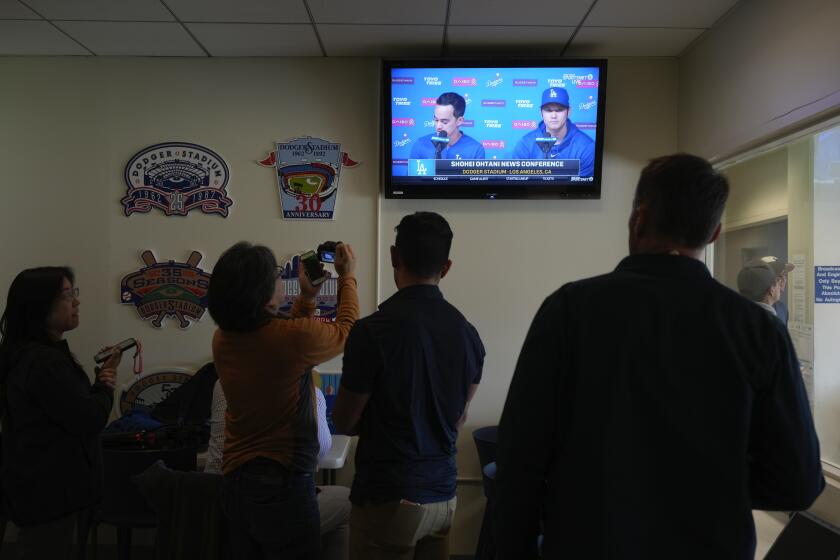
Japanese treat Shohei Ohtani gambling scandal like ‘presidential election.’ Media take his side
April 3, 2024

IMAGES
VIDEO
COMMENTS
Whilst BS 7671:2018+A2:2022 doesn't require other types of RCD testing, however additional tests are not precluded and may be useful for fault finding purposes, these tests could include: ½ x I Δn test. 5 x I Δn test. RCD type (AC, A, B, F) RCD tripping current (ramp test) Phase angle (0° & 180°)
Discuss 18th edition RCD max disconnection times!! in the UK Electrical Forum area at ElectriciansForums.net. Share this page. Facebook X (Twitter ... #1 Hi all. I am seeing different figures here all over the net, table3a (p363) states a 30ma RCD has a trip time of 300ms max. So at 5x is the maximum 60ms? I seem to recall 200ms and 40ms for a ...
No its not Ok it should trip on 1 times the operating current, try a ramp test, to test the mA tripping current of the RCD. Allow up to 200ms for 1 times (300mA) and 40ms for 5 times (1500mA), these are maximum operating times.
Type S (Time-delayed) A Type S RCD is a sinusoidal residual current device incorporating a time delay. It can be installed upstream from a Type AC RCD to provide selectivity. A time-delayed RCD cannot be used for additional protection because it will not operate within the required time of 40 mS. Type AC.
The test equipment should be selected to the type of RCCB corresponding to the type of RCCB within the installation. Should you wish to carry out a test at 250mA, where the required disconnection time is within 40 ms, a variable RCCB test instrument can be set to 50 mA and tested at X5, which is in effect car ...
For an RCD to provide Fault Protection the disconnection time (tripping time for the RCD) required for the circuit, as set out in Regulations 411.3.2.2 and 411.3.2.4, must be achieved AND RA x IΔn ≤ 50V, where RA = sum of resistance of the earth electrode and the resistance of the protective conductor connecting the exposed conductive parts.
The technical team at NICEIC & ELECSA provide guidance to the contractor when testing RCDs installed to provide additional protection having a 0.25 A (250 mA) residual operating current characteristic. Chapter 64 of the 18th Edition ( BS 7671) outlines the requirements and procedures that should be followed during initial verification or ...
A common misconception is that RCDs must trip in 30 ms. In fact, an RCD when tested at its rated sensitivity must trip in 300 ms. When tested at five times, ie, 150 mA for a 30 mA device, it should trip in 40 ms. A 10 mA device must always trip within 40 ms regardless of the test current. Changes to the Wiring Rules
Calculating this, 400 divided by 1.732 will give us 230.9 volts which we round DOWN to 230V. So for a 400 volt 3 phase system, U0 is 230 volts. The rest of the calculation is the same as before. Choose a row, choose a voltage range and the disconnection time is 0.4 seconds. Last one, example number 4.
Reg 411.5.3. However, according to the OSG 11.2 and 11.3 the max allowable time to trip for a 61008 and 61009 can be up to 300ms (or, as stated, less then 300ms so 299.99ms). If you are using RCBOs on circuits requiring 30mA protection and a selective type on the incoming it is 150 to 500ms on circuits without the RCBOs, so even worse.
This makes it possible to reduce the trip times between two residual current protections in series, increasing the margin of safety for any fault on the load side of the supply-side circuit-breaker, since its trip time is not as high as it should have been to obtain selectivity towards the load side with the classic method for time selectivity. ...
There's a small risk of lack of discrimination there - since RCDs usually can trip anywhere between >0.5x and ≤1x their rating, so the 500mA unit (if enthusiastic) could trip with residual currents above 250mA where the 300mA unit (if lazy) might not trip until 300mA - so if you had a residual current in the 250-300mA range (say due to ...
Gakure. -. Sep 17, 2017. #4. For the safety purpose, the fatal current to human body is about 50mA although any current above 10mA can still cause some harmful effects. At 5 times rated current of 30mA (150mA) if human or livestock are exposed beyond 40ms is fatal. At times of 30mA the body can withstand for upto 300ms but not more than that.
The 300mA RCD should be of the S type or have a time delay to avoid nuisance tripping. In addition, all live conductors should be isolated - i.e. the three line conductors and the neutral conductor. Note that all equipment installed in the glasshouse should be IP44 rated. BS 7671:2008 Section 705 deals with agricultural and horticultural ...
These response times below comply with the specifications of the IEC/EN 61008, ... (instead of 0,5 x 300mA = 150mA in IEC) Example : For a 300mA (IEC), the non tripping current (limit mini) is 300 x 0,85/1,15 = 221mA ... Shall not trip ultimately 2.0 . Time (ms) 10000 1000 Instantaneous Selective (S) Time- delayed (R) 100 100 300
Find all the transport options for your trip from Moscow to Zelenograd right here. Rome2Rio displays up to date schedules, route maps, journey times and estimated fares from relevant transport operators, ensuring you can make an informed decision about which option will suit you best. Rome2Rio also offers online bookings for selected operators ...
Tanveer Badal for The New York Times. 23. By Lauren Sloss. April 3, 2024. For our last night in La Paz, Mexico, we kept it simple: A couple of cans of cold Pacifico, a bench on the malecón, the ...
Overview. Distances. 220km Moscow to Vladimir; 23km Vladimir to Suzdal. Total time on train. approximately 3½ hours (Strizh: Moscow to Vladimir return) Total time on bus. 1-1½ hours (Vladimir to Suzdal return) Accessibility for foreigners rating. 4/5 - established tourist route, some English-speakers.
During his April 8-14 trip to the U.S., Kishida will hold talks with Biden at the White House on Wednesday, followed by a trilateral summit with Philippine President Ferdinando Marcos Jr. the next ...
Zelenograd State Historical Local Lore Museum. 21. History Museums. 5. Temple of the Prelate Nikolay Mirlikiysky. 22. Points of Interest & Landmarks • Architectural Buildings. 6. Bust Alexander Pushkin.
Alex Goodlett for The New York Times. On a Monday morning in early March, Reed Hastings, the billionaire co-founder and former chief executive of Netflix, clicked into the bindings on his ...
Trip MCB at times RCD too intervals days or hours; test if faulty appliance. Hi I am asking for help as a novice and 1st time user of this forum. Recently started to experience tripping of MCB & sometimes with the RCD at random times, intervals can be days after resets or several hours. Could an appliance or appliances be overloading the circuit?
Answer 1 of 7: Hello, my husband and I are visiting Moscow for 4 days and we want to visit the golden triangle area by train. We'd like to go to Vladimir, Suzdal and some other areas if possible for a day. We are budget tourist and would like to use public...
After all, we're not expected to have another total eclipse that's visible in the U.S. for nearly a decade, and that one will only be visible from the U.S. in the state of Alaska. Beyond that ...
The eclipse's path fortuitously cuts across Mexico, 15 U.S. states and a small part of eastern Canada. In all other states in the continental U.S., viewers will be treated to a partial solar ...
Kenny Holston/The New York Times. A White House spokeswoman said on Wednesday that the Israeli government had agreed to try to reschedule a visit by a group of officials whose trip to Washington ...
A network of sensors in the San Francisco Bay Area logged decreases in carbon emissions due to the use of electric vehicles. Here, traffic streams across the Bay Bridge in August 2020. A network ...
Quick question. Does anyone know the max trip time for a 100mA time delayed RCD. Max 500ms min 130ms. No good being 2 seconds as max disconnection times on a TT are 0.2 seconds and 1 second. Max resistance of Ra would be 500 ohms before 50v touch voltage is exceeded. 50/0.1 = 500 ohms for 100 mA rcd.
April 3, 2024 1:41 PM PT. MIAMI —. Taylor Ward homered, Nolan Schanuel extended his career-starting consecutive on-base streak to 35 games and the Los Angeles Angels beat Miami 10-2 on Wednesday ...